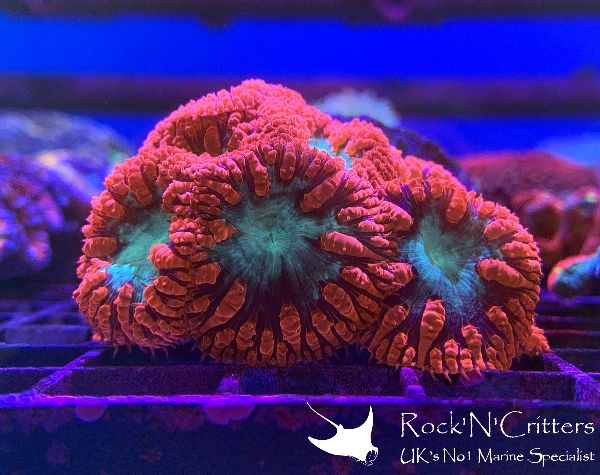
On the Coral Spotlight blog posts I'm going to pick a few corals that are in store and online. Some will be new arrivals and some are just nice pieces that I like or think deserve a bit of the limelight for a minute. Either way, here's a few corals for this month that I think are worth a look at, just click the coral name and it will take you to the RockNCritters online listing, enjoy!
1. Ultra Blastomussa. I've mentioned before that I quite like Acans so it's probably no surprise if I told you I'm a fan of Blastos. It must be the colony shape and polyp type of these sort of coral. Unlike Acans, there are a more limited colour variation of Blastos regularly on offer which is why I wanted to highlight these Ultra Blastos. There is both a colony size (as seen in the main picture) and frags in store but it is the colony that first grabbed my attention. The bright red contrasting against the luminous inner green on the large polyps is a real eye grabber.
Blastos aren't particularly demanding care-wise. They tend to better in lower or indirect lighting and low to moderate flow. Their large, fleshy polyps don't do well in high direct flow. The large polyps are capable of catching and digesting food such as Mysis shrimp and other finer coral foods will be readily accepted. I've used both Reef Roids, Mysis, SPS food and have new polyps growing on my pastel colony after just a month so I would say this is coral will grow at a moderate pace. Fast enough to keep you happy and slow enough so as to not take over the space in which they're placed.

2. Rainbow Pocillopora Frags. This is a really frustrating coral to try and get a decent photo of. I've tried over and over with my phone camera and different lenses but it's just one of those corals that refuses to photograph well. That is exactly why I've included it in this months spotlight because I think the coral is really quite nice and isn't fairly represented. The frags on offer in store are a good size too, don't be put off by me saying it doesn't photograph well because they certainly look good to the eye.
As for keeping this coral, I would group it in with the hardy SPS lot. Being an SPS coral, you'll need to be on top of your alkalinity, calcium and magnesium whilst also offering strong lighting and flow. Pocillopora is actually one of the main reef building corals so as long as you keep things stable it should grow well in your home reef tank. It's not going to be extending any sweeping stinging tentacles either to attack neighbouring corals but, when it gets going it could start to overshadow neighbouring corals so if you're adding it be sure to give it some space to grow into.
 |
![]()
3. Ultra Zoa Frags. Who doesn't like Zoas? There are so many colour variations out there whilst the prices of some rival even the most absurd named Acropora. I'm not sure what came first actually, named Zoas or named Acropora. Either way, both Zoas and Acros have cult followings. There are more and more Zoa frags and colonies appearing in store with some well-known named Zoas making an appearance as well. Why are Zoas on the list this month? There's some great frags with multiple polyps in store and I'll be honest, Zoas don't look out of place in any reef tank and are often a great place filler offering some colour and movement which the likes of montipora can't.
Zoas are a great beginner coral, hardy, colourful and good growers. They are photosynthetic so require good light to sustain them but this light doesn't need to be strong or direct. You can use a small particle food to supplement them and I've heard of people having good results with the likes of Reef Roids. The tricky part with Zoas can be their sulky attitude sometimes. The smallest thing can make them close up and stay closed up for some time. It's then hard to pinpoint the problem, whether it be a pest or flow etc. Patience and researching Zoa care is all that is needed though and you'll be well on your way to having Zoa colonies of your own.

4. Golden Pavona Frag. This to me looks like a piece of Jewellery, the Golden colour and intricately detailed lines between polyp mouths is really detailed and exactly why it's on the spotlight list this month. Pavona corals for me have that rare/less common label because you don't often see them showcased as much in peoples reef tanks or photo shoots but they really should be, they look great.
Pavona Corals are SPS and as such require stable parameters and medium to strong lighting. Good flow is important too in order to get nutrients to the coral and waste away. Pavonas are relatively easy and hardy corals to keep however so beginners shouldn't be put off.
![]()
That rounds up June's spotlight. There are far more corals in store though and some really nice pieces I just haven't got round to. If you're nearby to RockNCritters then pop in, find the corals in this spotlight and see what you think in person. Alternatively, have a look round the website, new corals are being added!